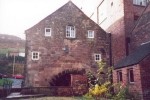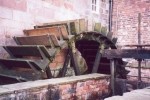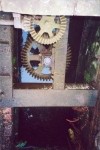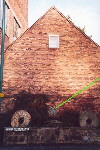|
Corn Mill at Leek In 1752, James Brindley rebuilt the Leek corn-mill that lies on the river Churnet. The diameter of the water-wheel is 16 feet and it is an 'under shot' type. This means that the drive water passes underneath it. The ground floor of the mill contains the gear wheels that transmit power from the waterwheel to the millstones on the first floor. Also on the first floor is a stone with the inscriptionT.I. 1752 J.B. confirming that the mill was designed and built by Brindley. The identity of T.I. is not known for sure but is most likely to be the initials of the man for whom the mill was constructed. Corn was ground in the mill until 1944. It was then used as a saw-mill and a garage despite part of it being demolished just after the war for street widening. In 1968 the building was classified as a designated Ancient Monument and it is now listed by English Heritage as of historic importance. The Brindley Preservation Trust (which was set up in 1970) purchased the mill in 1972 and began the process of restoration, which was completed in 1974. It is now a museum that demonstrates Brindley's work both as an architect and as a millwright.
|







